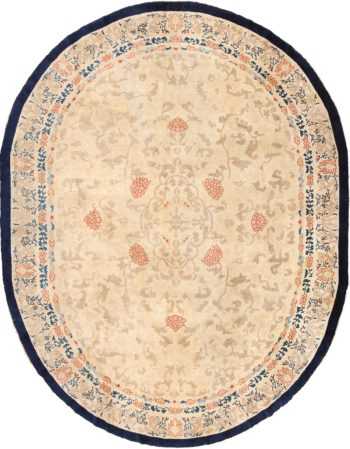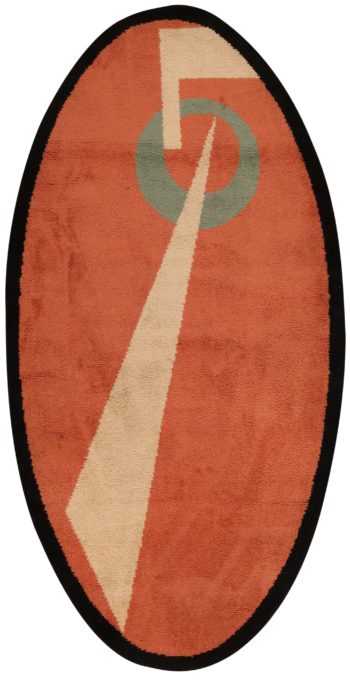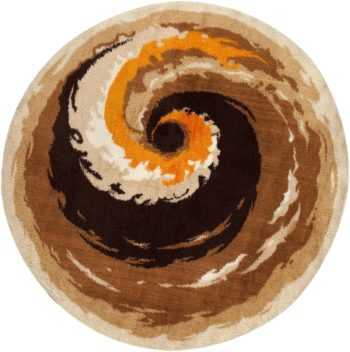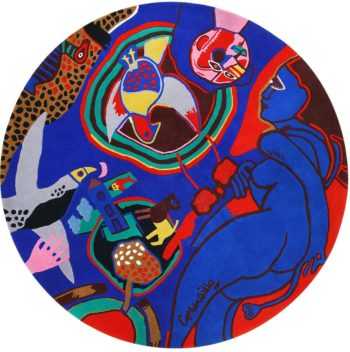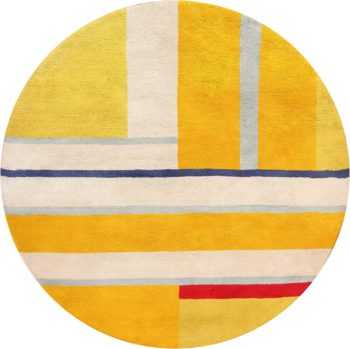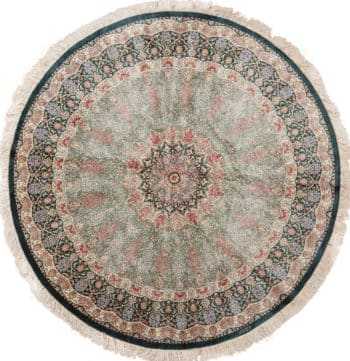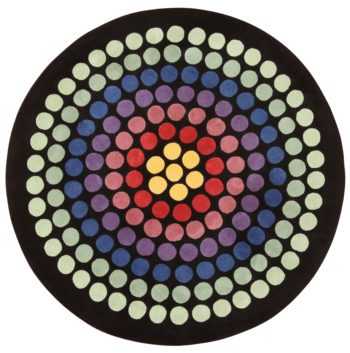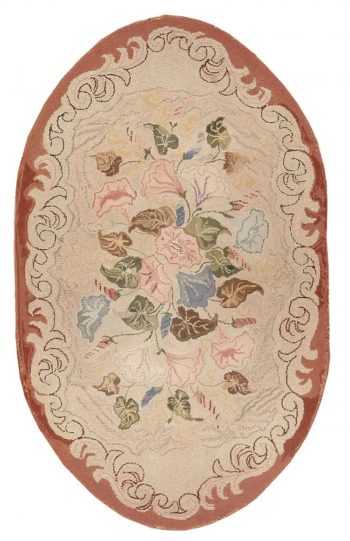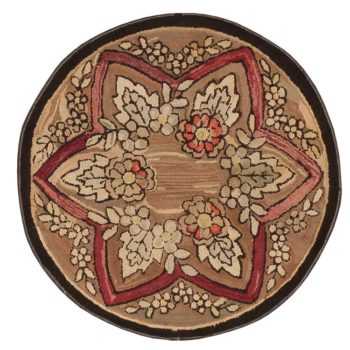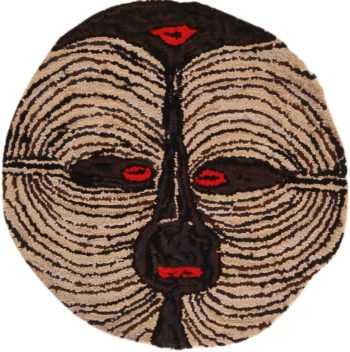Round Rugs
View our current vintage and antique collection of Round Rugs below:
-
Oversized Oval Antique English Axminster Rug 3155
$88,000.00Size: 14 ft 10 in x 20 ft 3 in (4.52 m x 6.17 m) -
Antique Cloud Band Design Oval Chinese Dragon Rug 49592
$16,900.00Size: 9 ft x 11 ft 7 in (2.74 m x 3.53 m) -
Vibrant Silk And Wool Modern Swedish Inspired Round Blue Rug 60925
$5,425.00Size: 9 ft 10 in x 9 ft 10 in (3 m x 3 m) -
Antique Art Deco French Oval Rug 71506
$5,600.00Size: 4 ft 5 in x 8 ft 7 in (1.35 m x 2.62 m) -
Light Ivory Fine Vintage Persian Gonbad Design Round Silk Qum Rug 72739
$13,125.00Size: 8 ft x 8 ft (2.44 m x 2.44 m) -
Round Shaggy Vintage Swedish Deco Rya Rug 46614
$5,900.00Size: 7 ft 3 in x 7 ft 3 in (2.21 m x 2.21 m) -
Vintage Round Corneille Art Rug 48332
$9,500.00Size: 7 ft 2 in x 7 ft 2 in (2.18 m x 2.18 m) -
Mid Century Vintage Round Corneille Rug 48201
$9,500.00Size: 7 ft 2 in x 7 ft 2 in (2.18 m x 2.18 m) -
Gold Round Ilya Yulievich Bolotowsky Art Rug 49949
$8,600.00Size: 7 ft x 7 ft (2.13 m x 2.13 m) -
Luxurious Fine Weave Intricate Floral Medallion Pattern Round Shape Vintage Persian Silk Qum Rug 72785
$11,550.00Size: 6 ft 7 in x 6 ft 7 in (2.01 m x 2.01 m) -
Vintage Round Scandinavian Rug By Verner Panton 71116
$8,500.00Size: 6 ft 7 in x 6 ft 7 in (2.01 m x 2.01 m) -
Vintage Round Swedish Shag Rya Rug 48193
$3,800.00Size: 6 ft x 6 ft (1.83 m x 1.83 m) -
Antique Oval Shape Floral American Hooked Rug 40328
$850.00Size: 2 ft 6 in x 4 ft (0.76 m x 1.22 m) -
Small Size Round Antique American Hooked Rug 40330
$1,800.00Size: 2 ft 8 in x 2 ft 8 in (0.81 m x 0.81 m) -
Artistic Vintage American Hooked Round Rug By Alice Black 71735
$1,450.00Size: 2 ft x 2 ft (0.61 m x 0.61 m)
Learn More About Antique and Vintage Round Rugs
Our vintage, circular, oval and round rugs are skillfully crafted works of art. These unique rugs were created by talented artists throughout the twentieth century, and each round rug has a classic style that represents the country and decade in which it was made. Whether you are looking for a small carpet or a large one, there is bound to be a rug in our collection that appeals to your home interior design aesthetics. All of our antique, limited edition products, flat-woven or pile rugs, have something special to offer.
Some of these round rugs feature an intricate network of lines and colors, while others confidently represent the more simplistic designs of the Art Deco movement.
Oval and rounder area rugs, much like angular ones, are designed to draw attention to a specific point on the ground. This point is usually arranged as a part of a whole, in turn leading the viewer’s eye to other sections that define the furnishings in the area. However, unlike traditional angular rugs, round rugs are designed to offset the linear nature of the surrounding room. With the presence of the floors, walls and doorways, there are already many angular lines defining the rigidity in the environment. With a round area rug, decorators can break up the traditional monotony through the use of softened spaces and more whimsical flows that lead the eyes in a less grounded manner.
No matter the colors or patterns chosen for the rugs, their round shape makes them ideal because the form echoes similar elements in the room. Items such as lighting fixtures, round circular shapes and appliances mesh with rounder rugs in a subtle yet elegant way. Especially in rooms such as kitchens and dens where such fixtures and circular arrangements are more prevalent. The casual appeal of the rugs, allows them to stand out without looking overdone.
Rounder rugs can also stand out as a perfect visual solution to opening up smaller rooms and allowing them to appear larger and more defined. This presence is ideal at the front of the room, where visitors can see the rug first and the rest of the furnishings next. Use these round rugs to create richer feelings of warmth, as the round shape implies softness and intimacy, especially when paired with colors such as orange, red and yellow. They can be applied by using many of the same techniques as with a standard rectangular rug.
Furnishings can be arranged around the rug itself, or the rug can be used to house several furnishings within its shape. No matter the arrangement, decorators are encouraged to be creative and apply their own personal preferences to the rugs to get the best visual effects.
How To Incorporate Round Rugs In Your Interior Decor
Rectangular rugs in rectangular spaces are such an easy and obvious choice. While they often work well, there is something to be said for a little uniqueness in your design. This can easily be accomplished by incorporating round rugs in our home decor. Round or circular rugs are a great choice to bring personality and style to a room. That said, they don’t always work in every single area of your home. Therefore, it is necessary to know when to choose decorating with round rugs.
Below are some suggested rules to follow when decorating with round rugs
What does a round rug do to a room?
A round rug can have several effects on a room, depending on its size, color, pattern, and placement.
Here are some ways a round rug can impact a room:
- Define a Space: Placing a round rug in a specific area can help define and delineate a particular space within a larger room. For example, it can create a cozy sitting area in a living room or define a dining space in an open-plan area.
- Add Visual Interest: The shape of the rug can add visual interest to a room that is otherwise dominated by straight lines and right angles. It introduces a different geometric element, breaking the monotony and contributing to a more dynamic design.
- Softens Angles: Round rugs can soften the sharp angles and straight lines of furniture and walls. This is especially useful in rooms with predominantly square or rectangular furniture, as the circular shape provides a contrasting and visually appealing element.
- Create a Focal Point: Placing a round rug strategically can draw attention to a particular area of the room, acting as a focal point. This is particularly effective if the rug has a bold pattern or vibrant color.
- Enhance Coziness: Round rugs can contribute to a sense of warmth and coziness in a room. This is especially true if the rug is made of soft materials like wool or shaggy fibers. The shape itself can create a more intimate and inviting atmosphere.
- Balance Design Elements: In rooms with predominantly square or rectangular furniture, a round rug can help balance the overall design. It introduces a contrasting shape that can prevent the space from feeling too rigid or predictable.
- Accommodate Circular Furniture Arrangements: If you have circular furniture, such as a round dining table or a conversation area with curved seating, a round rug can complement and enhance the arrangement.
- Maximize Small Spaces: In smaller rooms, a round rug can create the illusion of more space by avoiding the visual heaviness that square or rectangular rugs might bring. The absence of corners can make the room feel more open and less cluttered.
Ultimately, the impact of a round rug on a room depends on the specific design goals and the overall aesthetic you’re trying to achieve. It’s important to consider the size of the room, the existing furniture, and your personal style preferences when selecting and placing a round rug.
When To Use Round Rugs
Learning when to use round rugs is relatively straightforward. But, at the end of the day, it still comes down to personal preference, perception and statement.
Do you want a rug to blend into the background or would you want it to pop and be a focal point? You need your rug choice to balance with the interior design of the room. Sometimes that means adding a little pop of color or design when needed or wanted.
Consider using a circular rug in the following situations below:
• Highlighting Architecture – What is the architectural features of the space you’re decorating? Is the room round? Are there round elements? For example, is there a curved bay window? Circular rugs are great complements to architecture. Choosing the right round option can often highlight subtle details or soften major architectural elements of a room.
• Drawing Attention To Furniture and Objects – Do you have a round coffee table or entry table? Does your main living room or dining room have a chandelier? Consider using a round rug under these pieces of furniture to draw attention to them.
• Creating a Distinct Space – Sometimes, you have a large living area that you want to separate into smaller sections. Circular rugs are a great way to segment a room to create distinct spaces and nooks.
• Accenting the Carpeting – People often mistakenly believe that if they have carpeting, they can’t use area rugs. Nothing could be further from the truth. Layering rugs over carpeting or over big rugs can be a great way to add texture and interest to a space.
• Making Small Spaces Feel Larger – You can use a round rug to make a small space feel larger. While it may seem counter-intuitive, a circular rug can make a room appear less boxed in, more organic and more open.

Round rugs are the perfect accessory in open areas.
Ideas and Tips for Incorporating Round Rugs In Your Home
While you now understand when you can use round rugs, it can still be challenging to understand how to incorporate these rugs into your living area.
Thankfully, there a few ideas and tips that typically work when trying to bring in round rugs into your space:
• Place The Rug Under Round Furniture – The first and most obvious option is to place a round rug underneath a circular piece of furniture. However, this doesn’t just apply to tables. You can also place round rugs under seating with curved elements. For example, a rocking chair with its curved rungs is a perfect complement to a circular rug. An it goes without saying that using a round rug under a round sofa or couch is a very easy choice.
• Use The Rug In Minimally Designed Spaces – Some modern homes and designs can feel a little stark and sterile. This is fine if that’s your style, but a round rug can help warm up and draw attention to a specific space. You can use circular rugs with bold prints, but even a solid or neutral color rug will help create warmth and interest.
• Bring Whimsy To an Area – You can use a round happy colorful rug to bring a little fun to an area. As most people decorate with rectangular rugs, a round option automatically brings a sense of personality, but you can take that a step further by picking round rugs with bold designs. Make the rug the statement piece.
• Offset Rectangles – Rectangular rugs and shapes are the standard when it comes to universal design. But the standard can get boring. Using a round rug is a way of offsetting square pieces and creating a bit of visual interest in the process.

Use a round rug to identify a space.
Design Rules To Follow When Using Round Rugs
When it comes to design rules, it is necessary to remember that rules are subjective. Especially when it comes to personal taste and style. You are your own audience when it comes to designing your home. With that said, there are several guidelines that are generally accepted when it comes to using round rugs.
• Make It Big Enough – As with any rug, make it big enough. You want the carpet to reach under the front feet of furniture. Also, you want it to extend beyond the boundaries of a table, ensuring total coverage. For example, if using a circular rug under a circular dining table, make sure you have enough carpet to reach under the chairs.
• Use in Small Spaces – Use round rugs in smaller spaces to make the most impact. However, you can use circular rugs in a larger space, especially if you are creating little nooks or vignette seating areas. Rugs that are circular in shape are great for making statements and for providing visual interest.
• Pair With Similar Shapes – Drawing attention to objects by placing round rugs under similarly shaped furniture is more than a good idea, it’s a great rule of thumb. Circular rugs are great for enhancing the beauty of curves.

Consider the shape of your furniture when choosing a round rug.
You hopefully now have a good understanding of round rugs and how to use them. Check out some of our fantastic circular rugs and be inspired to bring them into your own space.
When not to use a round rug?
While round rugs can be a stylish and functional addition to many rooms, there are situations where they might not be the most suitable choice.
Here are some instances when you might want to reconsider using a round rug:
- Limited Floor Space: In smaller rooms or areas with limited floor space, a round rug might not be the most efficient choice. The circular shape can sometimes make a space feel more crowded, especially if the room is already compact.
- Mismatched Furniture Arrangement: If the furniture arrangement in a room is primarily linear or angular, introducing a round rug might create a visual clash. It’s essential to ensure that the rug complements the overall design and doesn’t conflict with the existing furniture shapes.
- High-Traffic Areas: Round rugs may not be the best option for high-traffic areas, such as hallways or entryways, where people are constantly walking through. Square or rectangular rugs tend to align better with the flow of foot traffic in such spaces.
- Under Large or Heavy Furniture: Placing a round rug under large or heavy furniture, such as a king-sized bed or a large dining table, might not showcase the rug’s shape effectively. It can get hidden, and the impact may be diminished.
- Irregularly Shaped Rooms: In rooms with irregular shapes, such as L-shaped or rooms with alcoves, a round rug may not fit well or look proportional. It’s essential to consider the room’s geometry and choose a rug shape that complements the space.
- Conflicting Patterns: If the room already has a lot of patterns in the decor, adding a round rug with a bold or busy pattern might create visual overload. In such cases, a simpler rug or one with a more subtle design might be a better choice.
- Formal Spaces: In some formal settings or traditional spaces, round rugs might not align with the established design aesthetic. Rectangular or square rugs are often more conventional choices for formal rooms.
- Budget Constraints: Round rugs can sometimes be more challenging to find and may be priced differently than their rectangular counterparts. If budget constraints are a concern, you may need to be flexible with the rug shape to find an affordable and suitable option.
Ultimately, the decision to use a round rug depends on your personal preferences, the room’s layout, and the existing decor. It’s essential to consider the overall design goals and functionality of the space before choosing a rug shape.
What room suits a round rug?
Round rugs can work well in various rooms, but they are particularly suitable for certain spaces and design scenarios.
Here are some rooms where round rugs are often a good fit:
- Living Rooms: Round rugs can work beautifully in living rooms, especially if you want to create a distinct sitting or conversation area. They can be placed under a circular coffee table or in the center of a seating arrangement to define the space.
- Dining Rooms: In dining areas with round tables, a round rug can complement the shape of the table and create a cohesive look. Make sure the rug is large enough to accommodate both the table and chairs, even when they are pulled out.
- Bedrooms: Round rugs can be an excellent choice for bedrooms, particularly if you have a round bed or want to soften the lines of a rectangular bed frame. Placing a round rug under a reading nook or accent chair in the bedroom can also add a cozy touch.
- Nurseries: Round rugs work well in nurseries, adding a playful and whimsical touch. They can be placed in the center of the room or under a crib to create a soft and inviting space for the baby.
- Entryways: In smaller entryways, a round rug can make a statement without overwhelming the space. It provides a welcoming focal point and helps define the entry area.
- Home Offices: If you have a dedicated home office with a circular desk or seating area, a round rug can enhance the visual appeal of the space. It can also be a good choice for smaller office nooks or corners.
- Sunrooms: Round rugs can complement the informal and relaxed atmosphere of sunrooms. Placing a round rug under a seating arrangement in a sunroom can create a cozy and inviting spot for relaxation.
- Children’s Playrooms: In spaces designated for play, round rugs can add a playful element. They work well under play tables or in reading corners, providing a comfortable and visually appealing area for children.
Remember that the size of the round rug is crucial. It should be proportionate to the size of the room and the furniture within it. Also, consider the overall design aesthetic and color scheme of the room when choosing a round rug to ensure it complements the existing decor.
Where do round rugs look best?
Round rugs can look best in various locations and design situations, depending on the overall layout and style of the space.
Here are some areas where round rugs often shine:
- Center of a Room: Placing a round rug in the center of a room, especially in larger spaces, can create a focal point. This is particularly effective if the rug has an eye-catching pattern or color that draws attention.
- Under Round Furniture: Round rugs naturally complement round furniture, such as circular dining tables, coffee tables, or accent chairs. Placing a round rug under these pieces helps tie the elements together and enhances the cohesion of the space.
- Small Spaces: In smaller rooms or cozy nooks, a round rug can add warmth and interest without overwhelming the limited space. It provides a defined area without creating visual clutter.
- Entryways: Round rugs work well in entryways, especially if the space is not too large. They can serve as a welcoming focal point and help define the entry area.
- Reading Nooks: If you have a dedicated reading corner with a comfortable chair or a chaise lounge, a round rug can be an excellent addition. It creates a cozy and inviting space for relaxation.
- Bedside: In bedrooms, round rugs can be placed on either side or both sides of the bed. This can add a soft and luxurious feel to the space, especially if the rug extends beyond the bed frame.
- Children’s Rooms: Round rugs are popular choices for children’s rooms. They can be placed under play tables, reading corners, or cribs, adding a playful and whimsical touch to the space.
- In Open-Plan Spaces: Round rugs can be used to define specific areas in open-plan living spaces. For example, they can delineate a seating area in a larger room without the need for walls or dividers.
- Bathrooms: In bathrooms with standalone tubs or vanities, a round rug can add comfort underfoot and contribute to a more luxurious feel.
- Outdoor Spaces: Round outdoor rugs can be placed on patios, decks, or in garden areas to define seating or dining areas. They add a touch of style and comfort to outdoor living spaces.
Remember to consider the size of the room, the furniture layout, and the overall design theme when choosing a round rug. It’s essential that the rug complements the existing elements in the space to achieve a cohesive and visually appealing look.
How do you arrange furniture with a round rug?
Arranging furniture with a round rug involves considering the size of the rug, the placement of key furniture pieces, and the overall layout of the room.
Here are some tips to help you arrange furniture with a round rug:
- Size Matters:
- Ensure that the round rug is appropriately sized for the room and the furniture arrangement. Ideally, the rug should be large enough to accommodate all the key furniture pieces within the seating area.
- Centering the Rug:
- Position the round rug in the center of the seating area. This is typically where the coffee table or central piece of furniture would be placed. The rug should extend beyond the edges of the furniture to create a cohesive and balanced look.
- Living Room Seating:
- If you’re placing the round rug in a living room, arrange the seating furniture around the perimeter of the rug. Sofas and chairs should have their front legs on the rug, creating a unified seating area.
- Dining Room Setup:
- In a dining room with a round rug, ensure that the rug is large enough for the dining table and chairs to fit comfortably. The rug should extend beyond the edges of the table, allowing for chairs to be pulled out without moving onto the hard floor.
- Bedroom Placement:
- In a bedroom, if you’re using a round rug beside the bed, position it so that it extends beyond the sides of the bed. This provides a soft landing area when getting out of bed and adds a decorative element to the space.
- Focal Point Emphasis:
- If the round rug has a distinctive pattern or color, consider placing it in a way that emphasizes a focal point in the room. This could be a fireplace, a feature wall, or another key element.
- Maintain Balance:
- Ensure a balanced look by distributing furniture evenly around the rug. Avoid clustering all the furniture on one side, as this can create an uneven and awkward appearance.
- Leave Space:
- Allow for some space between the edge of the rug and the walls of the room. This framing effect helps define the rug as a distinct area within the larger space.
- Consider Traffic Flow:
- Take into account the natural flow of traffic in the room. Make sure there is enough space around the rug for people to move comfortably without feeling cramped.
- Layering with Other Rugs:
- If you have multiple rugs in a room, such as a round rug layered on top of a larger rug, ensure that the placement is intentional and enhances the overall design.
Remember that personal preferences and the specific layout of your room will play a role in the arrangement. Experiment with different placements until you find the arrangement that best suits your style and functional needs.
Does a round rug look good with a square table?
Combining a round rug with a square table is certainly possible and can create an interesting and visually dynamic look.
However, there are a few considerations to keep in mind when incorporating circular rugs to ensure a harmonious and balanced design:
- Proportions: The key to making a round rug work with a square table is to consider the proportions. The rug should be large enough to extend beyond the edges of the table, allowing for comfortable chair movement without stepping off the rug. Ideally, the diameter of the round rug should be larger than the width and length of the table.
- Centering: Center the round rug underneath the square table, so the visual focus remains on the table and its surroundings. This helps anchor the table and creates a cohesive look in the dining area.
- Symmetry: Aim for symmetry in the arrangement. If the square table is centered on the round rug, ensure that the chairs are evenly spaced around the table, maintaining a balanced and pleasing aesthetic.
- Shape Play: The combination of a round rug and a square table adds an element of contrast and visual interest to the space. Embrace this contrast and consider it a deliberate design choice. The round rug softens the angular lines of the table and adds a touch of uniqueness to the room.
- Consistency in Design: Consider the overall design style and color scheme of the room. Ensure that the round rug complements the existing decor, including the square table and other furnishings.
- Layering: If you have a larger square rug that you’d like to incorporate into the design, you can layer a smaller round rug on top of it. This layering effect adds depth and texture to the space.
- Shape Echoing: Introduce other round or curved elements in the room to create a sense of cohesion. This could include rounded light fixtures, artwork, or accessories that echo the shape of the round rug.
- Color and Pattern Coordination: Coordinate the colors and patterns of the round rug with the surrounding elements, including the square table. This ensures that the rug blends seamlessly with the rest of the room.
Design is subjective, and personal preferences play a significant role. Experimenting with different arrangements and visualizing the interplay of shapes and lines in your dining area can help you determine if a round rug complements your square table and contributes to the overall aesthetic you desire.
Can I put a round rug in a rectangular room?
Absolutely, you can put a round rug in a rectangular room, and it can be a visually appealing and stylish choice.
Here are some considerations to keep in mind when placing a round rug in a rectangular room:
- Define a Focal Point: Use the round rug to define a specific area or create a focal point within the rectangular room. For example, you might position the round rug under a central coffee table in the seating area of a living room or under a dining table in a dining room.
- Balance with Furniture: Ensure that the furniture arrangement complements the round rug. In a rectangular room, you can place the round rug in a way that aligns with the furniture, creating a cohesive and balanced look.
- Room Size: Consider the size of the room and the dimensions of the round rug. The rug should be large enough to anchor the space and allow for sufficient floor coverage, but not so large that it overwhelms the room.
- Alignment: Experiment with different alignments for the round rug within the rectangular room. You can position it parallel to the longest walls or at an angle for a more dynamic effect. The key is to find an arrangement that enhances the flow of the room.
- Layering: If you have a larger rectangular rug, you can layer a smaller round rug on top of it. This adds depth and texture to the room and allows you to introduce both shapes into the design.
- Room Functionality: Consider the function of the room and how the round rug can enhance that functionality. For example, in a living room, it can define a conversation area, while in a bedroom, it can create a soft and cozy spot beside the bed.
- Harmony with Decor: Ensure that the round rug harmonizes with the overall decor and color scheme of the room. This includes coordinating with other furnishings, wall colors, and accessories.
- Traffic Flow: Keep in mind the natural flow of foot traffic in the room. The round rug should not obstruct pathways or impede movement within the space.
- Consistent Style: Maintain a consistent style throughout the room. If the room has a modern aesthetic, choose a round rug with contemporary patterns or textures. For a more traditional look, opt for a round rug with classic designs.
Ultimately, the key is to use the round rug intentionally to enhance the design of the rectangular room. Experiment with different arrangements and placements to find the configuration that best complements your style and the layout of the space.


